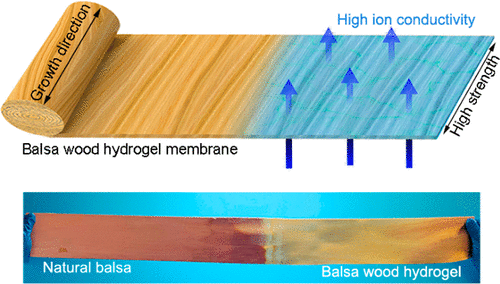Our official English website, www.x-mol.net, welcomes your
feedback! (Note: you will need to create a separate account there.)
Scalable Wood Hydrogel Membrane with Nanoscale Channels
ACS Nano ( IF 15.8 ) Pub Date : 2021-07-16 , DOI: 10.1021/acsnano.0c10117 Gegu Chen 1 , Tian Li 1 , Chaoji Chen 1 , Weiqing Kong 1 , Miaolun Jiao 1 , Bo Jiang 1 , Qinqin Xia 1 , Zhiqiang Liang 1 , Yang Liu 1 , Shuaiming He 1 , Liangbing Hu 1
ACS Nano ( IF 15.8 ) Pub Date : 2021-07-16 , DOI: 10.1021/acsnano.0c10117 Gegu Chen 1 , Tian Li 1 , Chaoji Chen 1 , Weiqing Kong 1 , Miaolun Jiao 1 , Bo Jiang 1 , Qinqin Xia 1 , Zhiqiang Liang 1 , Yang Liu 1 , Shuaiming He 1 , Liangbing Hu 1
Affiliation

|
Many efforts have been dedicated to exploring nanofluidic systems for various applications including water purification and energy generation. However, creating robust nanofluidic materials with tunable channel orientations and numerous nanochannels or nanopores on a large scale remains challenging. Here, we demonstrate a scalable and cost-effective method to fabricate a robust and highly conductive nanofluidic wood hydrogel membrane in which ions can transport across the membrane. The ionically conductive balsa wood hydrogel membrane is fabricated by infiltrating poly(vinyl alcohol) (PVA)/acrylic acid (AA) hydrogel into the inherent bimodal porous wood structure. The balsa wood hydrogel membrane demonstrates a 3 times higher strength (52.7 MPa) and 2 orders of magnitude higher ionic conductivity compared to those of natural balsa both in the radial direction (coded as R direction) and along the longitudinal direction (coded as L direction). The ionic conductivity of the balsa wood hydrogel membrane is 1.29 mS cm–1 along the L direction and nearly 1 mS cm–1 along the R direction at low salt concentrations (up to 10 mM). In addition, the surface-charge-governed ion transport also renders the balsa wood hydrogel membrane able to harvest electrical energy from salinity gradients. A current density of up to 17.65 μA m–2 and an output power density of 0.56 mW m–2 are obtained under a 1000-fold salt concentration gradient, which can be further improved to 2.7 mW m–2 by increasing the AA content from 25 wt % to 50 wt %. These findings make contributions to develop energy-harvesting systems and other nanofluidic devices from sustainable wood materials.
中文翻译:

具有纳米级通道的可扩展木质水凝胶膜
许多努力致力于探索用于各种应用的纳米流体系统,包括水净化和能源生产。然而,大规模创建具有可调通道方向和众多纳米通道或纳米孔的稳健纳米流体材料仍然具有挑战性。在这里,我们展示了一种可扩展且具有成本效益的方法来制造坚固且高导电的纳米流体木水凝胶膜,其中离子可以跨膜传输。离子导电轻木水凝胶膜是通过将聚(乙烯醇)(PVA)/丙烯酸(AA)水凝胶渗透到固有的双峰多孔木结构中制成的。轻木水凝胶膜的强度提高了 3 倍 (52. 7 MPa),离子电导率比天然轻木在径向(编码为 R 方向)和纵向(编码为 L 方向)高 2 个数量级。轻木水凝胶膜的离子电导率为 1.29 mS cm–1沿 L 方向和近 1 mS cm –1在低盐浓度(高达 10 mM)下沿 R 方向。此外,表面电荷控制的离子传输还使轻木水凝胶膜能够从盐度梯度中获取电能。在 1000 倍盐浓度梯度下获得高达 17.65 μA m –2的电流密度和 0.56 mW m –2的输出功率密度,通过增加 AA 含量可以进一步提高到 2.7 mW m –2 25重量%至50重量%。这些发现有助于利用可持续木材开发能量收集系统和其他纳米流体设备。
更新日期:2021-07-27
中文翻译:

具有纳米级通道的可扩展木质水凝胶膜
许多努力致力于探索用于各种应用的纳米流体系统,包括水净化和能源生产。然而,大规模创建具有可调通道方向和众多纳米通道或纳米孔的稳健纳米流体材料仍然具有挑战性。在这里,我们展示了一种可扩展且具有成本效益的方法来制造坚固且高导电的纳米流体木水凝胶膜,其中离子可以跨膜传输。离子导电轻木水凝胶膜是通过将聚(乙烯醇)(PVA)/丙烯酸(AA)水凝胶渗透到固有的双峰多孔木结构中制成的。轻木水凝胶膜的强度提高了 3 倍 (52. 7 MPa),离子电导率比天然轻木在径向(编码为 R 方向)和纵向(编码为 L 方向)高 2 个数量级。轻木水凝胶膜的离子电导率为 1.29 mS cm–1沿 L 方向和近 1 mS cm –1在低盐浓度(高达 10 mM)下沿 R 方向。此外,表面电荷控制的离子传输还使轻木水凝胶膜能够从盐度梯度中获取电能。在 1000 倍盐浓度梯度下获得高达 17.65 μA m –2的电流密度和 0.56 mW m –2的输出功率密度,通过增加 AA 含量可以进一步提高到 2.7 mW m –2 25重量%至50重量%。这些发现有助于利用可持续木材开发能量收集系统和其他纳米流体设备。













































 京公网安备 11010802027423号
京公网安备 11010802027423号